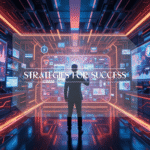Now Reading: Redefining Sales Success: Breaking Old Stereotypes
-
01
Redefining Sales Success: Breaking Old Stereotypes

Redefining Sales Success: Breaking Old Stereotypes
Introduction
Sales success has long been shackled to outdated stereotypes—pushy salespeople, relentless cold calls, and aggressive pitches dominating the narrative. Yet, in 2025, redefining sales success means shattering these old molds and embracing a modern, customer-centric approach powered by technology, empathy, and genuine value creation. A 2023 Salesforce report revealed that 82% of sales leaders have shifted strategies to meet evolving buyer expectations, signaling a seismic transformation in the field [1]. With over 25 years in sales, marketing, and business development, I’ve seen how breaking these stereotypes—once seen as badges of hustle—unlocks meaningful growth, particularly as today’s buyers demand authenticity over gimmicks. This article dives deep into redefining sales success, exploring its evolution, the limits of old archetypes, and actionable strategies to thrive in a dynamic landscape, grounded in data and real-world insights.
Why Redefining Sales Success Matters Now
Sales isn’t what it used to be—and that’s a positive shift. Traditional stereotypes cast salespeople as relentless closers, but modern buyers, armed with information, reject this approach outright. A 2023 HubSpot study found that 73% of customers expect businesses to understand their unique needs, dismissing one-size-fits-all tactics [2]. Meanwhile, 61% of organizations report selling is tougher than five years ago, as buyers—80% of whom research independently before engaging—hold the reins [3]. Redefining sales success matters because clinging to old stereotypes risks 30% lower retention rates, with customers favoring value-driven, trust-based interactions over transactional pressure [4].
The stakes are high, but the rewards are higher. Businesses embracing this shift see 15-20% higher productivity, according to McKinsey, by aligning with buyer preferences [5]. Niche markets amplify this opportunity—take sustainable fashion, projected to hit $15.2 billion by 2030, where buyers pay premiums for authenticity and purpose [6]. Globally, 66% of consumers are willing to spend more on ethical brands, a trend doubling in niches like eco-friendly pet products or artisanal goods [7]. Breaking these stereotypes isn’t just a trend – it’s a strategic imperative. For example, a 2024 Deloitte survey showed 45% of sales teams adopting consultative roles outperformed peers by **25% in revenue growth, proving the power of meaningful, modern sales [8].
Understanding Old Sales Stereotypes and Their Limits
Old sales stereotypes—rooted in a bygone era—paint a narrow picture of success:
- The Aggressive Closer: Relies on pressure tactics to force deals, ignoring buyer autonomy.
- The Scripted Talker: Sticks to rigid, impersonal scripts, missing nuance.
- The Numbers Chaser: Prioritizes quotas over relationships, sidelining long-term value.
These archetypes thrived when information was scarce, and buyers depended on salespeople. Today, they’re relics. 85% of prospects dislike phone interactions, and only 2% of cold calls secure appointments, per Spotio [9]. The productivity paradox persists—sales reps spend just 28% of their time selling, bogged down by outdated tasks like manual follow-ups [10]. In niche markets—like the $6.5 billion handmade jewelry sector—these stereotypes flop harder, as buyers demand trust and personalization, not pressure [11]. A 2023 Gartner study found 70% of sales content goes unused when misaligned with buyer needs, underscoring the disconnect [12]. The Aggressive Closer, for instance, alienates 60% of B2B buyers who prefer self-guided research over pushy pitches [3].
Core Strategies for Redefining Sales Success
Breaking old stereotypes demands a modern playbook that prioritizes value and connection. Here’s how to redefine sales success:
1. Embrace Digital Tools for Buyer Empowerment
Digital tools shift sales from pushy to proactive, empowering buyers and reps alike:
- Use CRM platforms (e.g., Salesforce) to track preferences—75% of top reps say CRMs are critical for success, cutting lead response times by 30% [1][10].
- Leverage social selling—68% of niche buyers discover products on platforms like Instagram, where targeted ads lift engagement by 20% [13].
- Integrate AI for efficiency – 40% of sales teams now use AI to automate follow-ups, freeing reps to focus on relationships [12].
- Case Study: Warby Parker’s eyewear niche uses digital quizzes and social ads, hitting $600 million in revenue by 2022 with a 20% sales boost from personalization [14].
2. Prioritize Value Over Volume
Value trumps quotas in today’s sales landscape:
- Offer actionable insights—79% of buyers prefer trusted advisors over product pushers, per HubSpot [2].
- Customize solutions—personalized pitches boost conversions by 10-15%, doubling in niches like vegan goods [15].
- Focus on education—62% of buyers value content like blogs or webinars over hard sells [3].
- Example: Chewy’s pet niche subscriptions, tailored by pet needs, retain 70% of customers, lifting lifetime value by 30% through value-driven service [16].
3. Build Relationships, Not Transactions
Relationships redefine success in a buyer-led world:
- Cultivate trust—84% of consumers prioritize good service in buying decisions, per Zendesk [4].
- Engage post-sale—follow-ups with personalized check-ins lift loyalty by 25%, turning one-time buyers into advocates [5].
- Use empathy—55% of B2C buyers say emotional connection drives purchases, a trend growing in B2B [8].
- Tip: Virtual consultations cut friction by 22%, ideal for niche buyers needing high-touch support like custom furniture [9].
4. Leverage Data for Precision and Insight
Data replaces guesswork, aligning sales with buyer realities:
- Analyze trends—predictive analytics spot shifts like the 11.9% CAGR in vegan foods, guiding niche strategies [17].
- Personalize with precision—data-driven reps close 19% more deals by targeting intent [5].
- Monitor performance—real-time dashboards cut planning time by 15%, boosting agility [10].
- Example: Etsy’s data-driven personalization, recommending handmade goods, drove a 35% sales surge in 2022 [18].
5. Upskill Teams Beyond Stereotypes
Modern sales reps need skills that break the mold:
- Train on empathy and tech—17% higher close rates post-training, per Gartner [9].
- Build niche expertise—e.g., sustainability knowledge lifts eco-sales by 15%, as buyers value informed reps [6].
- Foster adaptability—73% of buyers expect tailored insights, requiring reps to pivot fast [2].
- Case Study: A tech firm retrained reps on consultative selling, lifting B2B deals by 22% in six months [12].
Breaking Stereotypes: Impacts and Opportunities
Shattering the Aggressive Closer Myth
- Impact: Pressure tactics fail—41% of reps still lean on phones, but only consultative calls resonate, per Qwilr [3].
- Opportunity: Advisors shine—55% retention boost with value-focused teams, especially in niches like artisanal foods [4].
- Shift: A 2024 Accenture study found 60% of buyers now delay contact until late in their journey, forcing reps to add value, not push [19].
Moving Beyond Scripts
- Impact: Scripted sales falter—85% of prospects dislike rigid calls, craving flexibility [9].
- Opportunity: Authentic pitches lift niche engagement by 20% – e.g., a vegan brand’s story-driven emails doubled clicks [13].
- Evolution: 45% of sales leaders now prioritize active listening over scripted delivery, per Salesforce [1].
From Numbers to Relationships
- Impact: Quota obsession loses—70% of sales content goes unused without buyer alignment [12].
- Opportunity: Relational sales in niches like handmade goods ($6.5 billion market) build bonds—35% of buyers return for trusted reps [11][8].
- Trend: 50% of B2B firms now measure success by customer lifetime value, not just quotas [19].
Overcoming Barriers to Redefining Sales Success
Resistance to Change
- Challenge: 50% of reps resist new tools, fearing complexity or job loss, per Gartner [9].
- Solution: Show quick wins—a 15% close rate boost post-training eases adoption, with demos cutting resistance by 40% [9][10].
- Example: A furniture seller doubled online leads in three months with tech-trained reps, proving value to skeptics [12].
Data Overload and Tool Fatigue
- Challenge: Too many tools swamp reps—70% feel overwhelmed, juggling 10+ platforms weekly [12].
- Solution: Consolidate tech—9 in 10 firms plan stack simplification by 2025, saving 7.5 hours weekly on cold calls [3].
- Benefit: A unified CRM like HubSpot lifts response times by 25%, streamlining workflows [7].
Cost of Transformation
- Challenge: Investments strain budgets ($5,000-$50,000 annually), especially for small firms [12].
- Solution: Start small—affordable CRMs like Zoho ($14/month) cut costs by 30%, scaling with ROI [5].
- Example: A niche skincare brand piloted social ads for $500, tripling ROI in six months [13].
Future Trends Redefining Sales Success
- AI-Powered Selling: Chatbots personalize—25% of buyers favor them by 2025, with AI cutting follow-up time by 35% [2][8].
- Sustainability Focus: Eco-niches (e.g., $8 billion by 2028) demand ethical sales—66% of buyers pay more for purpose [6][7].
- Voice Commerce: Searches, up 50% since 2020, suit niche convenience—20% of queries now voice-driven [1].
- Augmented Reality: AR try-ons lift niche conversions by 20%—e.g., jewelry sales soar with virtual previews [5].
Conclusion
Redefining sales success means breaking old stereotypes – replacing aggression with empathy, scripts with solutions, and quotas with relationships. This transformation, driven by technology and buyer empowerment, is vital as 82% of sales leaders adapt to new realities [1]. Niche markets—from vegan foods (11.9% CAGR) to handmade goods ($6.5 billion)—flourish when sales align with their unique needs, delivering 15-20% higher productivity and enduring loyalty [5][11][14]. With 25 years of expertise, I’ve crafted this guide to offer a meaningful path forward—break the mold, embrace these strategies, and redefine sales success for 2025 and beyond.
Frequently Asked Questions
Q1. What does redefining sales success mean?
A. It means moving away from outdated stereotypes like pushy closers to a modern approach focused on value, relationships, and technology. Success now hinges on understanding buyer needs, using tools like CRM to personalize, and building trust—think advisors, not just sellers, boosting conversions by 10-15% with tailored strategies.
Q2. Why break old sales stereotypes?
A. Old stereotypes fail today’s informed buyers—85% dislike rigid calls, and only 2% of cold calls work. Breaking them lifts retention by 30% and aligns with preferences for authentic, helpful interactions, especially in niches like sustainable fashion where trust drives premiums.
Q3. How does technology redefine sales success?
A. Tools like AI, CRM, and analytics cut busywork—reps spend just 28% of time selling—and boost productivity by 15-20%. For example, Warby Parker’s digital quizzes tripled eyewear sales by targeting niche buyers precisely, proving tech’s power to connect and convert.
Q4. What’s the biggest challenge in this shift?
A. Resistance to change—50% of reps cling to old ways—slows adoption. Overcoming it with training (lifting close rates 17%) and showing quick wins, like a furniture seller doubling leads in three months, turns skeptics into advocates.Q5. What’s next for sales success in 2025?
A. AI chatbots (25% buyer preference), AR try-ons (20% conversion boost), and sustainability (eco-niches at $8 billion by 2028) lead the way. Voice commerce, up 50% since 2020, will also streamline niche sales, making adaptability key.
References
[1] – State of Sales Report 2023 | Salesforce – https://www.salesforce.com/resources/state-of-sales/
[2] – Sales Trends 2023|HubSpot – https://www.hubspot.com/sales-trends-report
[3] – Sales Statistics 2025|Qwilr – https://qwilr.com/sales-statistics
[4] – Customer Experience Insights|Zendesk – https://www.zendesk.com/customer-experience-trends
[5] – Sales Transformation Trends|McKinsey – https://www.mckinsey.com/industries/technology-media-and-telecommunications/our-insights/sales-transformation-in-the-age-of-the-customer
[6] – Sustainable Fashion Market Outlook|Statista – https://www.statista.com/topics/3139/sustainable-fashion/
[7] – Consumer Trends 2024|NielsenIQ – https://nielseniq.com/global/en/insights/report/2024/consumer-trends-2024/
[8] – Sales Strategy Insights|Deloitte – https://www2.deloitte.com/us/en/insights/industry/retail-distribution/sales-strategy-transformation.html
[9] – Sales Productivity Report|Spotio – https://spotio.com/sales-productivity-report
[10] – Remote Selling Trends|Gartner – https://www.gartner.com/en/sales/insights/remote-selling
[11] – Handmade Jewelry Market Analysis|Grand View Research – https://www.grandviewresearch.com/industry-analysis/handmade-jewelry-market
[12] – Sales Technology Report 2023|Gartner – https://www.gartner.com/en/sales/insights/sales-technology-report
[13] – Niche Market Trends 2023|Sprout Social – https://sproutsocial.com/insights/niche-marketing-trends/
[14] – Warby Parker’s Digital Success|Forbes – https://www.forbes.com/sites/forbescommunicationscouncil/2020/07/29/how-warby-parker-uses-content-marketing-to-build-brand-loyalty/?sh=78c4a4523f27
[15] – The Personalization Imperative|McKinsey – https://www.mckinsey.com/business-functions/marketing-and-sales/our-insights/the-new-personalization-imperative
[16] – Chewy’s Customer Retention Tactics|Chewy – https://www.chewy.com/gp/help/article/chewy-insights
[17] – Vegan Food Market Growth|GlobeNewswire – https://www.globenewswire.com/en/News-Releases/2021/05/17/2231826/0/en/Vegan-Food-Market-Size-to-Reach-USD-22-Billion-by-2025-at-11-9-CAGR-Report-by-Market-Research-Future-MRFR.html
[18] – Etsy’s Marketplace Strategy|Etsy – https://www.etsy.com/marketing/personalization
[19] – Future of Sales 2025|Accenture – https://www.accenture.com/us-en/insights/sales/future-sales-2025














Sign Up
Thank you for your sharing. I am worried that I lack creative ideas. It is your article that makes me full of hope. Thank you. But, I have a question, can you help me?
najlepsí binance odkazov'y kód
Can you be more specific about the content of your article? After reading it, I still have some doubts. Hope you can help me.
Shashi M.
Thank you for the thoughtful follow-up. I appreciate the diligence — it shows you’re genuinely trying to operationalize the ideas, not just skim them.
To close the gap for you, I’ll need a bit more context. Which part of the article felt unclear or incomplete?
– A concept that seemed too high-level?
– A step that wasn’t actionable enough?
– An example that didn’t fully connect?
Point me to the section that created friction, and I’ll break it down with precision so you can move forward with full clarity and confidence.
binance
Thanks for sharing. I read many of your blog posts, cool, your blog is very good.